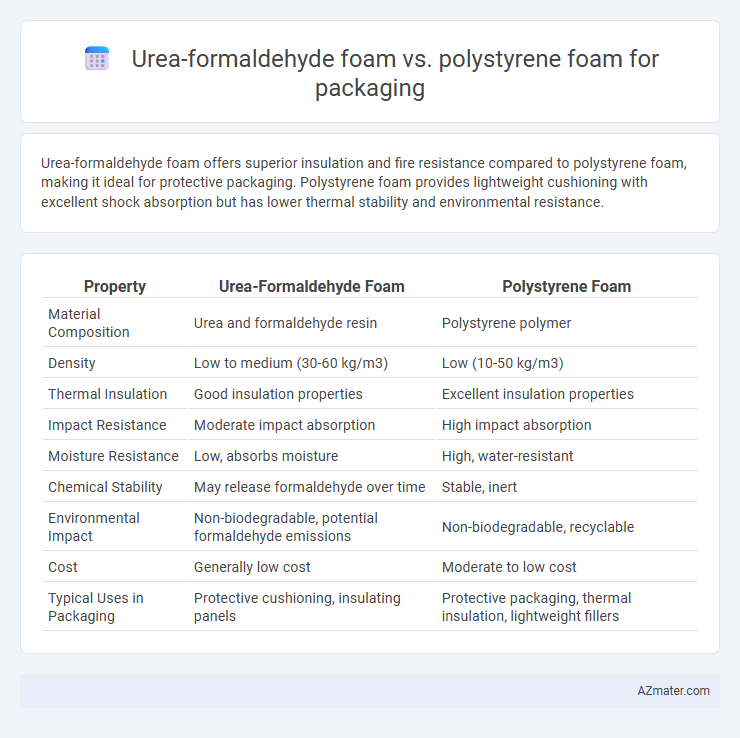Urea-formaldehyde foam offers superior insulation and fire resistance compared to polystyrene foam, making it ideal for protective packaging. Polystyrene foam provides lightweight cushioning with excellent shock absorption but has lower thermal stability and environmental resistance.
Table of Comparison
| Property | Urea-Formaldehyde Foam | Polystyrene Foam |
|---|---|---|
| Material Composition | Urea and formaldehyde resin | Polystyrene polymer |
| Density | Low to medium (30-60 kg/m3) | Low (10-50 kg/m3) |
| Thermal Insulation | Good insulation properties | Excellent insulation properties |
| Impact Resistance | Moderate impact absorption | High impact absorption |
| Moisture Resistance | Low, absorbs moisture | High, water-resistant |
| Chemical Stability | May release formaldehyde over time | Stable, inert |
| Environmental Impact | Non-biodegradable, potential formaldehyde emissions | Non-biodegradable, recyclable |
| Cost | Generally low cost | Moderate to low cost |
| Typical Uses in Packaging | Protective cushioning, insulating panels | Protective packaging, thermal insulation, lightweight fillers |
Introduction to Urea-Formaldehyde and Polystyrene Foams
Urea-formaldehyde foam is a rigid, thermosetting resin-based material characterized by its high insulating properties and fire resistance, commonly utilized in packaging for its lightweight and structural strength. Polystyrene foam, a petroleum-based polymer, offers excellent cushioning, moisture resistance, and cost-effectiveness, making it a popular choice for protective packaging applications. The distinct chemical compositions of urea-formaldehyde and polystyrene foams influence their thermal stability, mechanical durability, and environmental impact in packaging solutions.
Chemical Composition and Manufacturing Processes
Urea-formaldehyde foam consists of polymerized urea and formaldehyde resin, formed through a condensation reaction that creates a rigid, thermoset network, making it brittle but heat resistant. Polystyrene foam is derived from polymerized styrene monomers expanded with a blowing agent, resulting in a lightweight, thermoplastic material with excellent cushioning properties. Manufacturing urea-formaldehyde foam involves mixing and curing chemicals under controlled temperatures, whereas polystyrene foam production relies on polymerization and physical expansion processes like steam heating to create cellular structures.
Physical and Mechanical Properties Comparison
Urea-formaldehyde foam exhibits higher compressive strength and better thermal stability than polystyrene foam, making it suitable for heavy-duty packaging applications requiring impact resistance. Polystyrene foam offers superior lightweight properties and flexibility, with excellent cushioning effects due to its low density and resilience. Both materials differ significantly in water absorption rates; urea-formaldehyde foam has higher moisture sensitivity compared to the hydrophobic nature of polystyrene foam, influencing durability in humid environments.
Insulation and Protective Capabilities
Urea-formaldehyde foam offers superior thermal insulation with a low thermal conductivity of approximately 0.03 W/m*K, making it highly efficient for temperature-sensitive packaging applications. Polystyrene foam, particularly expanded polystyrene (EPS), provides excellent cushioning and impact resistance due to its closed-cell structure, ensuring strong protective capabilities against mechanical shocks. Both materials balance insulation and protection, but urea-formaldehyde foam excels in thermal retention while polystyrene foam dominates in physical shock absorption.
Moisture Resistance and Durability
Urea-formaldehyde foam exhibits lower moisture resistance compared to polystyrene foam, making it less suitable for environments with high humidity or direct water exposure. Polystyrene foam demonstrates superior durability due to its resilience against compression and impact, while urea-formaldehyde foam tends to become brittle over time. The hydrophobic nature of polystyrene enhances long-term performance in packaging applications requiring moisture protection and mechanical robustness.
Environmental Impact and Biodegradability
Urea-formaldehyde foam releases formaldehyde, a toxic compound that poses environmental hazards and contributes to indoor air pollution, whereas polystyrene foam, though chemically inert, significantly burdens landfills due to its non-biodegradable nature. Polystyrene takes hundreds of years to degrade, leading to persistent microplastic pollution affecting marine and terrestrial ecosystems. Urea-formaldehyde foam degrades more readily under specific conditions but can emit harmful gases during decomposition, complicating its environmental profile.
Cost Analysis and Availability
Urea-formaldehyde foam offers a lower production cost compared to polystyrene foam due to its simpler chemical composition and widespread raw material availability. Polystyrene foam, while slightly more expensive, provides enhanced durability and insulation properties, justifying its higher price in specialized packaging applications. Both materials are widely available globally, but urea-formaldehyde foam is more prevalent in markets prioritizing cost-efficiency over performance.
Safety and Health Considerations
Urea-formaldehyde foam releases formaldehyde gas, posing respiratory risks and potential carcinogenic effects, requiring careful handling and adequate ventilation during use. Polystyrene foam, while generally inert, can emit toxic styrene fumes when burned, and its fine particles may pose inhalation hazards during manufacturing or disposal. Both materials necessitate proper safety measures to mitigate exposure-related health concerns in packaging applications.
Common Packaging Applications
Urea-formaldehyde foam and polystyrene foam are extensively utilized in packaging for their excellent insulation and cushioning properties. Urea-formaldehyde foam is commonly applied in protective packaging for delicate electronic components and glassware due to its high compressive strength and thermal insulation. Polystyrene foam dominates in packaging applications such as food containers, shipping insulation, and lightweight protective packaging for consumer goods because of its moisture resistance and shock-absorbing capabilities.
Choosing the Best Foam for Packaging Needs
Urea-formaldehyde foam offers excellent thermal insulation and rigidity, making it suitable for packaging fragile items requiring structural support. Polystyrene foam, notably expanded polystyrene (EPS), provides superior shock absorption and lightweight protection, ideal for cushioning electronics and delicate goods. Selecting the best foam depends on packaging demands, balancing thermal resistance, impact cushioning, and cost efficiency.

Infographic: Urea-formaldehyde foam vs Polystyrene foam for Packaging
 azmater.com
azmater.com